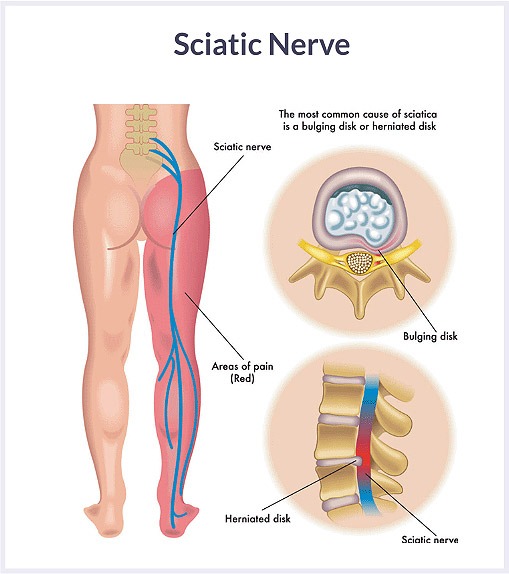Back Pain Treatment Home » Conditions Treated » Sciatica
All About Sciatica
The term ‘Sciatica’ is often confused with generalized lower back pain. Sciatica refers to the pain that arises when the sciatic nerve gets irritated.
The Sciatic nerve is one of the longest nerves in your body. It starts at the lower back, runs through your buttocks, goes down your legs, and ends just below your knees. It controls the muscles of your lower leg and sensation in most of your legs and feet.
According to the Harvard school of medicine, at least 40 percent of individuals get sciatica during their lifetime.
What are the symptoms of sciatica?
Common symptoms of sciatica include:
- Pain in the back shooting to your legs and toes.
- One-sided (unilateral) leg pain greater than back pain.
- Numbness or pins and needles in the legs, feet or toes.
- Straightening and raising your leg while lying down (straight leg raise test) worsens the pain.
- Unilateral weakness of the muscles of thighs, legs, and feet.
- Muscle spasm in the back, legs or feet.
What causes sciatica?
Sciatica is usually caused by lower back problems, particularly by disorders of the spine, such as a bulging or herniated disc, intervertebral disc degeneration, displacement of vertebral bones, bone spurs, joint cysts, or narrowing of the spaces between vertebral bones. These disorders can cause the compression the sciatic nerve, leading to inflammation, pain and numbness in the affected leg.
The common causes of Sciatica are:
- Bulging or herniating lumbar intervertebral discs. (Most common cause of Sciatica.)
- Spondylolisthesis, a condition in which one vertebra slips over the other.
- Spinal stenosis, which is narrowing of the spine.
- Muscle spasms in the back or legs.
- Injury to the back.
- Other conditions like pregnancy, malignancy, infection of the spine, and damage during surgery can also lead to Sciatica.
Regenerative Medicine Treatments for Sciatica
Intradiscal Bone Marrow Aspirate (BMA)
This procedure includes injecting Bone Marrow Aspirate (BMA) into the damaged intervertebral discs. As part of a cell-based treatment, regenerative cells can be collected from bone marrow and blood with minimal discomfort. These cells can then be processed in a state-of-the-art laboratory utilizing the latest technology. Finally, the regenerative cells, in combination with natural growth and healing factors, can be injected into the intervertebral discs.
the discseel® procedure
The Discseel® Procedure injects an FDA approved biologic into the damaged intervertebral discs. This provides support to the discs and boosts their regeneration. This can repair your damaged disc. If needed, we can add bone marrow aspirate into the disc.



